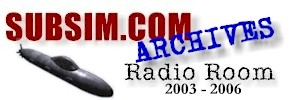| View previous topic :: View next topic |
| Author |
Message |
amrcg
Joined: 02 Jan 2004
Posts: 39
|
 Posted: Tue Dec 14, 2004 9:24 am Post subject: DIFAR sonobuoys Posted: Tue Dec 14, 2004 9:24 am Post subject: DIFAR sonobuoys |
 |
|
I have a doubt about the implementation of DIFAR sonobuoys. Directional sonobuoys must send the noise together with bearing info to the monitoring platform, so that the latter is able to know which noise was produced in which bearing. However, although DIFAR sonobuoys have 99 VHF channels available, they can only operate in one channel at a time. So they must multiplex the noise coming from all bearings in a single VHF channel (which can be selected using EFS commands in the UHF channel). My question is about the general principle behind this bearing multiplexing. As a comms engineer, the way I think this is implemented is by making a round-robin multiplexing of all bearings, transmitting noise from one bearing at a time and possibly signalling the currently active bearing in the UHF channel (assuming that the sonobuoy has UHF transmission capability, which I'm not sure). Otherwise, if only the VHF channel is used, inband DTMF signalling could be used to signal the start of a noise transmission for a different bearing. Otherwise, the only way I envisage is for the monitoring platform to explicitly signal which bearing it wants to listen to using the UHF EFS commands.
Could someone confirm if some of this is true?
Regards,
Antonio |
|
| Back to top |
|
 |
Smuook
Joined: 13 Jan 2004
Posts: 112
Location: Florida
|
 Posted: Tue Dec 14, 2004 11:04 pm Post subject: Posted: Tue Dec 14, 2004 11:04 pm Post subject: |
 |
|
I'm not an communications engineer... however, I do know some basics:
The basic older directional sonobuoys contained an omni hydrophone, two directional hydrophones, amps, compass, modulators, oscillator, muliplexor, and transmitter.
The acoustic signal is basically a carrier signal with directional sideband signals. It is compass corrected internally then goes out as an amplitude modulated analog fm signal. The phase of the output signal determines the magnetic bearing to the planes acoustic processors.
Newer sonobuoys signals are generated by a microprocessor |
|
| Back to top |
|
 |
Smuook
Joined: 13 Jan 2004
Posts: 112
Location: Florida
|
 Posted: Tue Dec 14, 2004 11:48 pm Post subject: Posted: Tue Dec 14, 2004 11:48 pm Post subject: |
 |
|
More about CFS (command function select)...
The initial sonobuoy channel (of rf) is set in the plane. If it's loaded externally in the belly, you can't change it until deployed. The internally loaded one's are loaded in the "p-chutes"... these can be set by the ordnanceman in the plane. Once you set this to a specific sonobuoy... you generally don't change it. That buoy uses that RF to receive the acoustic VHF signal. All that buoys acoustic information and bearing comes over that signal.
The only time you have to change an RF by using CFS is either that channel is noisy or there is interference from another sonobuoy in the water with the same channel.
Proper planning usually prevents the need to change channels... you can check the channels prior to deploying to see if they are noisy... and you can plan your sonobuoy interference between you and other units to prevent having the same RF's in the water. If the need does occurs, it is a useful function however.
The CFS is a seperate reserve UHF that is receive by the bouys diplexer. |
|
| Back to top |
|
 |
compressioncut
Joined: 21 Jun 2003
Posts: 238
Location: Canada
|
 Posted: Thu Dec 16, 2004 12:29 am Post subject: Posted: Thu Dec 16, 2004 12:29 am Post subject: |
 |
|
| Smuook wrote: |
Proper planning usually prevents the need to change channels... you can check the channels prior to deploying to see if they are noisy... and you can plan your sonobuoy interference between you and other units to prevent having the same RF's in the water. If the need does occurs, it is a useful function however.
|
Just for the interest of others, that is called the SIAP - Sonobuoy Interference Avoidance Plan. The ASWC/OTC/OCS*, whomever, will promulgate one prior to an event. Individual units will be assigned specific channels, and they are not to use any others unless told to by the appropriate authority. It's especially important for some units, like a Halifax frigate, because the receiver on board only does 32 channels. It's bad if that unit gets a SIAP of 64-74.
Prior planning, etc.
*ASWC = AntiSubmarine Warfare Commander
*OTC = Officer in Tactical Command
*OCS = Officer Conducting Serial |
|
| Back to top |
|
 |
|
|
You cannot post new topics in this forum
You cannot reply to topics in this forum
You cannot edit your posts in this forum
You cannot delete your posts in this forum
You cannot vote in polls in this forum
|
Powered by phpBB © 2001, 2005 phpBB Group
|

